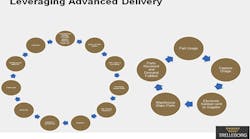MH&L’s readers submit several good questions every week for our panel of experts to field. Most of them deal with complex logistics issues, but every once in a while we get some pretty simple ones—sometimes deceptively simple.
Take this one, for example:
“What are the linkages and differences between demand management and materials management in logistics?”
At first I wasn’t sure this question was worthy of consideration, not only because it was so seemingly basic, but because the term “materials management” seems a bit out-of-date in this era of supply sourcing complexity. However, after seeing the following quote from an executive of the National Retail Federation, this question seemed more appropriate than ever:
“Increasing congestion at the nation’s ports as well as the ongoing West Coast labor negotiations are ongoing concerns and retailers are making one last push to make sure they’re stocked up for the holidays."—Jonathan Gold, NRF Vice President for Supply Chain and Customs Policy“Increasing congestion at the nation’s ports as well as the ongoing West Coast labor negotiations are ongoing concerns and retailers are making one last push to make sure they’re stocked up for the holidays,” NRF Vice President for Supply Chain and Customs Policy Jonathan Gold said. “Retailers are working hard to make sure customers can find what they’re looking for regardless of what happens at the ports.”
Retailers and manufacturers are trying to manage while surrounded by seemingly unmanageable factors—many of them affecting the materials they handle for customers in their chains. That could lead to erring on the over-side of material readiness rather than the under-side. The NRF’s monthly Global Port Tracker report, done in conjunction with Hackett Associates, predicts that import cargo volume at the nation’s major retail container ports will surge and set a new monthly record in October as the holiday season approaches. It is expected to total 1.53 million containers, topping the 1.52 million monthly record set in August. In fact, cargo volume has been well above average each month since spring as retailers have imported merchandise early in case of any disruption on the docks.
Jim Tompkins, CEO of Tompkins International, took the first crack at our reader’s question:
“Demand management is a current term dealing with customer wants, and materials management is an older term dealing with supply management. The linkage between them is the desire to synchronize demand to supply.."—James Tompkins, CEO, Tompkins International“Demand management is on the opposite side of the supply chain from supply management,” he responded. “Demand is what the customer wants, supply is how much we can make available. The goal of the profession of supply chain management is to synchronize supply and demand.
“The term materials management is not used as frequently today as it was 10-20 years ago. Materials management was the first third in a trio: materials management, material flow and physical distribution of materials and information within the link of a supply chain. Where materials management dealt with supply, material flow is within manufacturing, and physical distribution deals with fulfilling demand. So, demand management is a current term dealing with customer wants, and materials management is an older term dealing with supply management. The linkage between them is the desire to synchronize demand to supply.”
Tan Miller, director of the global supply chain program at Rider University, added on to Jim’s comment, proving why it’s such a challenging question: “Demand management has become extraordinarily complex in today’s world,” he said. “It involves evaluating, selecting and then managing the multiple channels of distribution (i.e., logistic channels) by which a firm can reach and satisfy the demand of its customers.”
With the economy on an upswing, it looks like those customers are in a buying mood, which makes supply management even more challenging.
“The consumer is back,” said Hackett Associates Founder Ben Hackett, citing reduced unemployment, improved consumer confidence and other indicators. “That’s all good news for retailers, ports and shipping lines.”
It’s good news if suppliers and their transportation providers can meet that demand in a timely fashion while staying faithful to the lean philosophy that their CEOs have come to expect for bottom-line performance. In a new MH&L gallery, Jeff Primeau, senior manager in the supply chain practice of management and technology consulting firm West Monroe Partners, offers seven ways companies can reduce inventory levels across their supply chains while accommodating demand and any snafus that tend to happen at the worst times. View the Gallery here...






